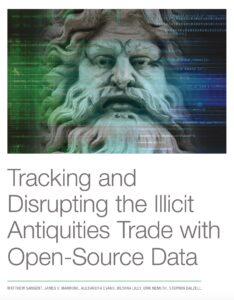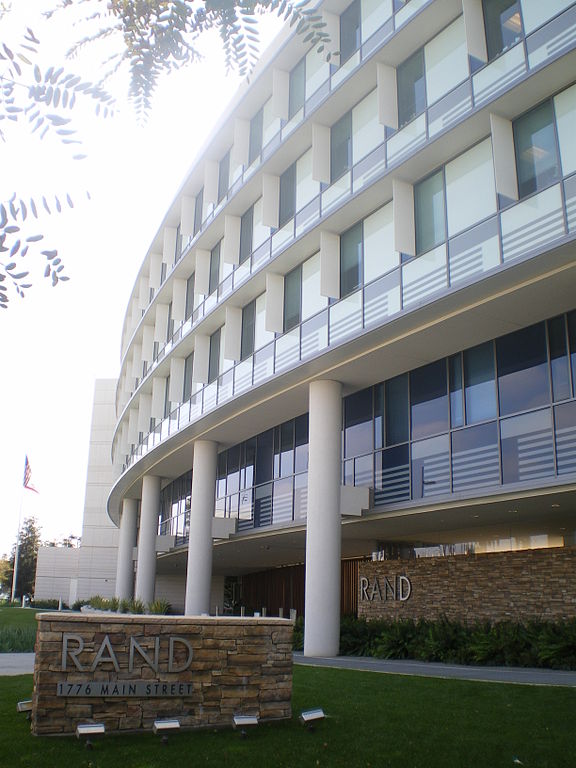The author and Cultural Property News wish to express their appreciation to IADAA for its contributions to this and other reporting on the RAND Corporation publication, Tracking and Disrupting the Illicit Antiquities Trade with Open Source Data.
“We find no evidence that illegal sales are occurring in large or even steady quantities on deep web platforms, such as Facebook or Telegram, and we find virtually no evidence of antiquities being traded on the dark web.”
“Despite the arguments forwarded by antiquities blogger Katie Paul, who has assumed that the few examples of deep web or cryptocurrency transactions she has found are evidence of a more extensive hidden market, we find no evidence that the dark web hosts more than a trivial market for these goods.”
Matthew Sargent, James V. Marrone, Alexandra Evans, Bilyana Lilly, Erik Nemeth, and Stephen Dalzell, Tracking and Disrupting the Illicit Antiquities Trade with Open Source Data, RAND, 2020, pp. xii, 43
Facebook announced on June 23, 2020 that it would remove content “that attempts to buy, sell or trade in historical artifacts” on its Facebook and Instagram platforms. In a Product Policy Forum, Facebook outlined various options, stating, “…we have not, to date, prohibited the sale or exchange of historical artifacts in organic content… because such items hold significant personal and cultural value to certain communities and can be sold and acquired legally across various jurisdictions…however… the sale of historical artifacts can result in harmful behaviour…”[1]
Facebook cited three reasons for the policy change: (1) commentators describe the global market in antiquities is a ‘grey market’, (2) there is a good chance that historical artifacts traded online are either illegal or fake, as an estimated 80% of antiquities have ‘sketchy provenances,’ and (3) there is criticism that Facebook’s policy has led the platform to become a digital black market where users buy and sell illicit antiquities originating from conflict zones.”
Facebook defined historical artifacts as “rare items of significant historical, cultural, or scientific value. This applies specifically to:
- Products of archaeological discoveries and excavations
- Antiquities such as ancient funerary items, ancient tombstones, ancient coins, engraved seals
- Human remains and mummified body parts
- Ancient scrolls and manuscripts
Yet Facebook’s policy change appears to be driven by inaccurate information – both about what is happening on Facebook and about the antiquities market in general. One organization, ATHAR, headed by Katie Paul, former Director of Programs at the Capitol Archaeological Institute at The George Washington University in Washington, D.C and one-time Research Director of the Antiquities Coalition, has heavily promoted claims about Facebook’s supposed ties to a massive network of illegal traders in antiquities. However, one of the most highly respected professional research organizations in the United States, the RAND Corporation, has issued a major report calling these claims into question and criticizing both ATHAR’s methodology and its conclusions.
ATHAR Project Takes the Credit
Katie Paul and Amr Al-Azm of the ATHAR Project were happy to take the credit for Facebook’s decision. “Its Official We did it. Facebook has banned the sale of Antiquities,” tweeted Amr Al-Azm on June 23.
Facebook’s decision was prompted by a stream of articles appearing in the mainstream and archaeological press alleging that “social media, in particular Facebook” is “the biggest marketplace for illegal antiquities.”[2] Many press articles repeated identical claims. They derived primarily from a 90-page publication by Paul and Al-Azm entitled “Facebook’s Black Market in Antiquities; Trafficking Terrorism, and War Crime,” published in June 2019.
The publication, compiled by Katie Paul and Amr Al-Azm of the newly formed Antiquities Trafficking and Heritage Anthropology Research (ATHAR) Project, features intensive speculation on the volume of illicit traffic made possible through Facebook and other web portals. The ATHAR report criticized Facebook’s failure to police illegal activities by antiquities-oriented user groups, stating that Facebook and other portals allowed criminals, including transnational networks supporting terrorist activities, to sell looted objects and promote ‘looting for hire.’ The report also included dozens of screenshots of internet offerings of alleged antiquities for sale. According to the ARTHAR report:
“In total, there are 488 individual admins controlling a collective 1,947,195 members across 95 Facebook antiquities trafficking Groups.”[3]
ATHAR’s 2019-2020 Facebook campaign followed on an earlier series of articles by Katie Paul[4] and Amr al-Azm, alleging the existence of another major center for the illegal antiquities trade on the dark web, paralleling and in conjunction with the dark web’s drug and weapons sales.
RAND Corporation Report Blows ATHAR Claims Away

Matthew Sargent, James V. Marrone, Alexandra Evans, Bilyana Lilly, Erik Nemeth, Stephen Dalzell, “Tracking and Disrupting the Illicit Antiquities Trade with Open-Source Data,” Rand Corporation, 2020.
A major 2020 study by the RAND Corporation, Tracking and Disrupting the Illicit Antiquities Trade with Open Source Data[5], undercuts many of the claims made by ATHAR. The report found that the entire narrative on the antiquities trade has been “dominated by speculation and hypotheses.”[6] The RAND report found that popular narratives claiming that organized networks of international criminals were looting for hire were unsubstantiated. Instead of the purported multi-billion dollar Western market for illegal objects, RAND found only ad-hoc, opportunistic looting that chronically oversupplied a much smaller, less organized, and geographically diffused market. Facebook and Instagram posts were replete with fakes, and goods were offered in the Mideast at prices similar to Western legal markets. It states,
“We find that the entire market (looted or not) is not likely to be larger than a few hundred million dollars each year. Even this is likely an overestimate, given that our appraisals contain data with fakes, replicas, and other nonantiquities.”[7]
The RAND report was researched at the RAND Homeland Security Operational Analysis Center, which is partially funded by the U.S. Department of Defense. According to the report, the supposed massive, web-based trade in illicit antiquities described in the popular press does not exist:
“We find no evidence that illegal sales are occurring in large or even steady quantities on deep web platforms, such as Facebook or Telegram, and we find virtually no evidence of antiquities being traded on the dark web.”[8]
and
“Despite the arguments forwarded by antiquities blogger Katie Paul, who has assumed that the few examples of deep web or cryptocurrency transactions she has found are evidence of a more extensive hidden market, we find no evidence that the dark web hosts more than a trivial market for these goods.’[9]
The RAND study also points out how relying on questionable data can be counter-productive in finding effective solutions to the problems of looting and cultural destruction.
The RAND report describes how Facebook feeds a treasure-hunting mythology:
“Many of the largest [Facebook] groups operate as voyeuristic lifestyle sites, where users would share glamorous images of gold artifacts, treasures, and valuable antiquities, with occasional accounts of treasure-hunting explorations of finds that make the riches seem attainable. The group projected the idea that this was a world in which treasure hunting—looting—could yield wealth within easy reach.”
“This curated image is largely an illusion. Using Google’s reverse-image search quickly reveals that the majority of the images posted on these groups are actually recycled images from news articles and museum websites. Similarly, images that show gold artifacts still buried in the ground are often photos from professional archaeological excavations or stock photographs.”[10]
and
“Specifically, we found that Facebook is a prominent hub for discussions of antiquities, which may be driving interest in looting by highlighting the wealth that it purportedly generates. By promoting and normalizing looting in Arabic-language groups, Facebook has the potential to drive looting even if there is not sufficient demand in the market to sell the looted goods.”[11]
Mixed Motivations
Although ATHAR’s widely publicized campaign undoubtedly spurred Facebook’s decision to take a more critical look at Middle Eastern and North African users attempting to sell antiquities, that step is unlikely to be effective in halting looting.
As the BBC’s Steve Swann noted in an article on Facebook’s decision:
“In other words, although RAND’s research reveals that not much demand exists for looted material, those who exaggerate the problem – either to increase public pressure on the antiquities trade or to secure funding for projects – effectively encourage looting.”[12]
While a RAND study footnote stated that the ATHAR campaign “provides valuable insights into the details of the antiquities trade on Facebook, their analysis does not change our overall assessment that while it is a highly visible entrypoint into antiquities looting and trafficking the volume of transactions conducted through the platform is relatively modest.[13]
Dark Web Trafficking Questioned

Dark Web, Caption: La web oscura se refiere al contenido en línea encriptado que no está indexado por los motores de búsqueda convencionales. Photo by Anonymous, Creative Commons Attribution-Share Alike 4.0 International license.
RAND’s analysis also shows there is virtually no evidence of antiquities sales on dark web platforms:
“Technology used in the looted antiquities trade is mostly unsophisticated. Studies of other illegal goods suggest that the dark web would be a natural place to sell looted antiquities. However, our analysis of dark web platforms finds virtually no evidence of antiquities sales. On deep web platforms, such as Telegram and Facebook, we also find little evidence of antiquities sales, although other secure messaging applications, such as WhatsApp and Viber, are used to coordinate sales and streamline communications within existing networks. We agree with other researchers who have concluded that the low level of enforcement and the existence of low-risk sales channels reduces the need for dark or deep web sales of antiquities.”[14]
The study noted that while it could not prove that a dark web trade did not exist (it’s virtually impossible to prove that a mythological narrative, like Santa, does not exist) there was no evidence or logical basis for claiming that it did.
“… because we cannot directly prove the null hypothesis that there is no large-scale antiquities trading on the dark web, we instead ask about the dark web’s value to the trade and demonstrate that these features are poorly aligned with the illicit antiquities market. Although it provides anonymity and security, the dark web also limits the size of the audience that sellers can reach by requiring that they access a site using specific browsing software and a specific connection protocol. Moreover, because many dark web sites are not indexed and searchable, potential buyers cannot easily find the goods they are looking for unless they know where to look. Finally, the anonymity afforded by these sites also limits the establishment of trust between buyers and sellers through identity-based reputation. These features impose transaction costs that make the dark web a poor match for most categories of transactions.”[15]
No Connection to Weapons or Drug Trafficking
RAND found no evidence that trafficking in antiquities/cultural property in the Mideast overlaps trade in drugs and weapons. The study traced oft-repeated story back to a single original source, U.S. Marine Corps Reserve Colonel Matthew Bogdanos’s experiences during the Iraqi Civil War.[16]
“Traders in these [dark web] markets estimate that drug sales account for 90 percent of all goods sold, with guns making up another 5 percent.”[17] “Among the 20,000 postings for weapons, only four ancient coins were offered for sale. Of these four, only the one pictured in the article could be identified, and the others were so worn that their markings and inscriptions were illegible.”[18]
The RAND researchers looked at dark web postings in a variety of countries and languages:
“When we analyzed the postings for antiquities, we found that no art, antiquities, or coinage were listed for sale among the current postings on Hydra [Russia’s leading dark web site]. A more systematic search of archived postings on dark web marketplaces likewise failed to find evidence that these markets were used as a channel for antiquities sales. Analysis of two years of postings on Dream Market, one of the largest dark web marketplaces, also failed to reveal postings for art or antiquities… Searches for a standard battery of antiquities-related word stems yielded only drug paraphernalia with ancient-looking designs. No ancient coins were indicated—only a handful of modern coins or coins advertised as forgeries of modern coins were listed.”[19]
The list of languages and the findings [on the dark web] are presented as follows:
- Arabic No art, antiquities, or coinage
- Kurdish No art, antiquities, or coinage
- Turkish No art, antiquities, or coinage
- Persian No art, antiquities, or coinage
- Hebrew No art, antiquities, or coinage
- Greek No art, antiquities, or coinage
- Bulgarian No art, antiquities, or coinage
- Russian No art, antiquities, or coinage
- German No art, antiquities, or coinage
- English No art, antiquities, or coinage.
“Although the results of these searches are not definitive because of the necessarily incomplete coverage of the dark web provided by aggregators such as Sixgill, there is no evidence that the dark web serves as a platform for antiquities transactions.”[20]
The report concludes, “As noted in our analysis, the dark web is not well suited to the demands of the antiquities market; the limited audience, the high transaction costs relative to the value provided, and the need for in-person inspection of goods limit the utility of these platforms for antiquities dealers.”[21]
“Looted” Goods Offered on Web Channels may not even be Illict, and they are Likely to be Fake
One of the most striking characteristics of the dozens of posts depicting objects in Facebook and other web postings in the ATHAR report is that the alleged looted antiquities, despite being depicted at the “looting site” where they were ostensibly found, are obvious fakes. The RAND report emphasized that majority of objects shown to its researchers in Turkey were also easily identifiable as fakes even in poor cellphone images. This is unsurprising, since it is far easier to fake an antiquity than to locate one in the ground.

Maamoun Abdulkarim, DGAM photographer, 23 November 2014, Creative Commons Attribution-Share Alike 4.0 International license.
The RAND report cites to an interview with similar information:
“Maamoun Abdulkarim, Directorate-General for Antiquities and Museums in Syria, said the percentage of fakes among looted antiquities seized in Syria and Lebanon had risen from 30 percent to 70 percent in the past three years. As he explained, “Hoaxers are exploiting the growing black market in Middle Eastern antiquities by creating fake artifacts to dupe unsuspecting collectors.”[22]
It also notes the following about a surprisingly active source country for so-called Mediterranean antiquities:
“Perhaps more striking [about sales on eBay] is the high volume of sales from Thailand, a country not typically associated with Roman antiquity. An analysis of a sample of the individual sales suggest that many, or perhaps most, of these the items are fake.”[23]
And the RAND report echoes findings similar to the criticism regarding seizures of caches of antiquities in Bulgaria:
“The services of these forgers are in high demand; by some estimates, as much as 80 percent of the coins and other artifacts exported from Bulgaria are forgeries. One factor in the increased volume of forgeries is that the vast majority of archaeological sites in Bulgaria have already been extensively plundered, especially the upper archaeological layer in the top 12 inches to 16 inches of soil. As looters provide fewer original artifacts to their middlemen, criminal networks have attempted to compensate for the reduced supply with forgeries.”[24]
If this is the case – and recent seizures in Pandora and other law enforcement raids in Bulgaria show similarly unauthentic material – it indicates that the widespread local coin collecting community is either kept underground or that collections have been sold into other EU nations due to economic disruption in Bulgaria.[25]
Bad Data Results in Bad Policy
The 166-page RAND report is based on stringent review of all the available data, and therefore essential reading for policymakers who have thus far relied on sources that are now called into question for their veracity if not for their good intentions. There have already been serious legal and economic consequences resulting from the circulation of inaccurate, even wildly exaggerated misinformation on the size and nature of the antiquities market. These include highly restrictive EU[26] and German[27] legislation on the importation of ancient art, the 5th EU Anti-Money Laundering Directive[28] and attempts to pass U.S. legislation to make antiquities dealers subject to the same stringent customer-information collecting and reporting requirements as banks for art sales as little as $50,000 per year.[29]
The RAND report succinctly states that:
“Online markets and discussion forums are some of the most visible elements of the antiquities trafficking supply chain, but we must be careful not to overstate their importance simply because they are more easily tracked than the interpersonal networks…”[30]
Not the least of the problems resulting from relying on Facebook, Instagram, and other web-based data to define the illicit market – as the authors of the RAND study note – is the fact that myths about market size and the wealth derived from antiquities actually encourage looting – despite the reality of a small-size market that does not want looted items and could not possibly handle this volume of goods. Accurate data, a rational methodology, and a coherent explanation of the structure and scope of the illicit market can more properly guide policy to stem illegal trafficking. It is hoped that the RAND Corporation’s eminently rational approach will also enable policy decisions that facilitate the continuation of a lawful, transparent and accountable trade in artifacts.
[1] Product Policy Forum, Recommendation: Sale of Historical Artifacts, Facebook, June 23, 2020.
[2] Katie Paul, Facebook Is The Biggest Marketplace of Illegal Antiquities, Alliance to Counter Crime Online, 3 July 2019. https://medium.com/alliance-to-counter-crime-online/facebook-is-the-biggest-marketplace-of-illegal-antiquities-b0e95927398f
[3] Amr Al-Azm and Katie A. Paul, Facebook’s Black Market in Antiquities; Trafficking Terrorism, and War Crime, Antiquities Trafficking and Heritage Anthropology Research (ATHAR) Project, 2019, p 19.
[4] Katie Paul, Ancient Artifacts vs. Digital Artifacts: New Tools for Unmasking the Sale of Illicit Antiquities on the Dark Web, Antiquities Coalition, Arts, 2018,7, 12; doi:10.3390/arts7020012
[5] Matthew Sargent, James V. Marrone, Alexandra Evans, Bilyana Lilly, Erik Nemeth, and Stephen Dalzell, Tracking and Disrupting the Illicit Antiquities Trade with Open Source Data, xii, Rand Corporation, Santa Monica, California, 2020, https://www.rand.org/pubs/research_reports/RR2706.html
[6] Id. at 146.
[7] Id. at xii.
[8] Id. at xii.
[9] Id. at 43. The RAND report cites to “Katie A. Paul, “Ancient Artifacts vs. Digital Artifacts: New Tools for Unmasking the Sale of Illicit Antiquities on the Dark Web,” Arts, Vol. 7, No. 2, February 2018,” and clarifies that Paul did not have access to data unavailable to RAND. Id., footnote 1.
[10] Id. at, 54-55, see also Figures 4.3–4.4, 55, 56
[11] Id. at 67.
[12] Steve Swann, Facebook bans ‘loot-to-order’ antiquities trade, BBC News, 23 June 2020, https://www.bbc.com/news/world-middle-east-53140615
[13] Sargent, et al, Tracking and Disrupting the Illicit Antiquities Trade with Open Source Data, footnote 18, 59-60.
[14] Id. at xiii.
[15] Id. at 44.
[16] Id. at 50.
[17] Id. at 45.
[18] Id. at 50. The one attractive coin was offered for sale in the posting for $850. The same coin is available in the legal market for $125.
[19] Id. at 46.
[20] Id. at 47. For similar conclusions about Telegram, see page 51.
[21] Id. at 64.
[22] Id. at 39.
[23] Id. at 80-81.
[24] Id. at 109.
[25] Mark Fox, Bulgaria Seeks Import Restrictions, Numismatic News, October 31, 2011, http://www.numismaster.com/ta/numis/Article.jsp?ad=article&ArticleId=24311, stating that, “Of the some 50,000 coin collectors in this country (enlisted in the early 1990s at the numismatic clubs), only around 150-200 collections were de facto declared by this law. The rest simply vanished, buried in bank safes, hidden in the ground, etc. The owners just did not want to bother.”
[26] Kate Fitz Gibbon, Art Imports to EU Threatened by Draconian Regulation, Cultural Property News, December 29, 2018, https://culturalpropertynews.org/art-imports-to-eu-threatened-by-draconian-regulation/
[27] Kate Fitz Gibbon, Restrictive German Cultural Property Law Now In English, Cultural Property News, August 18, 2017, https://culturalpropertynews.org/restrictive-german-cultural-property-law-now-in-english/
[28] CCP, EU 5th Anti-Money Laundering Directive Program Notes, Cultural Property News, March 19, 2019, https://culturalpropertynews.org/notes-from-an-aba-program-on-eu-5th-anti-money-laundering-directive/
[29] CCP, Bill Requiring Antiquities Dealers to Report Transactions Passes House – Expansion to All Art Trade Urged, Cultural Property News, November 3, 2019, and What’s Next for 2020? Art Blockades, Money Laundering Rules, OFAC Sanctions, Cultural Property News, December 19, 2019, https://culturalpropertynews.org/whats-next-for-2020-art-blockades-money-laundering-rules-ofac-sanctions/
[30] Sargent, et al, Tracking and Disrupting the Illicit Antiquities Trade with Open Source Data, at 43.
 Rand Corporation Headquarters, Main Street, Santa Monica, California, Photo by Cbl62
18 January 2007, Creative Commons Attribution-Share Alike 3.0 Unported license
Rand Corporation Headquarters, Main Street, Santa Monica, California, Photo by Cbl62
18 January 2007, Creative Commons Attribution-Share Alike 3.0 Unported license 

